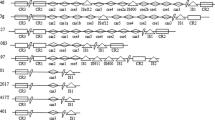Abstract
The recently discovered CRISPRs (Clustered regularly interspaced short palindromic repeats) and Cas (CRISPR-associated) proteins are a novel genetic barrier that limits horizontal gene transfer in prokaryotes and the CRISPR loci provide a historical view of the exposure of prokaryotes to a variety of foreign genetic elements. The aim of study was to investigate the occurrence and distribution of the CRISPRs in Shigella. A collection of 61 strains of Shigella were screened for the existence of CRISPRs. Three CRISPR loci were identified among 61 shigella strains. CRISPR1/cas loci are detected in 49 strains of shigella. Yet, IS elements were detected in cas gene in some strains. In the remaining 12 Shigella flexneri strains, the CRISPR1/cas locus is deleted and only a cas3’ pseudo gene and a repeat sequence are present. The presence of CRISPR2 is frequently accompanied by the emergence of CRISPR1. CRISPR3 loci were present in almost all strains (52/61). The length of CRISPR arrays varied from 1 to 9 spacers. Sequence analysis of the CRISPR arrays revealed that few spacers had matches in the GenBank databases. However, one spacer in CRISPR3 loci matches the cognate cas3 genes and no cas gene was present around CRISPR3 region. Analysis of CRISPR sequences show that CRISPR have little change which makes CRISPR poor genotyping markers. The present study is the first attempt to determine and analyze CRISPRs of shigella isolated from clinical patients.


Similar content being viewed by others
References
Ashkenazi S, Cleary KR, Pickering LK, Murray BE, Cleary TG (1990) The association of Shiga toxin and other cytotoxins with the neurologic manifestations of shigellosis. J Infect Dis 161:961–965
Barrangou R, Fremaux C, Deveau H, Richards M, Boyaval P, Moineau S, Romero DA, Horvath P (2007) CRISPR provides acquired resistance against viruses in prokaryotes. Science 315:1709–1712
Bikard D, Hatoum-Aslan A, Mucida D, Marraffini LA (2012) CRISPR interference can prevent natural transformation and virulence acquisition during in vivo bacterial infection. Cell Host Microbe 12:177–186
Bateman A, Rawlings ND (2003) The CHAP domain: a large family of amidases including GSP amidase and peptidoglycan hydrolases. Trends Biochem Sci 28:234–237
Bennish ML, Harris JR, Wojtyniak BJ, Struelens M (1990) Death in shigellosis: incidence and risk factors in hospitalized patients. J Infect Dis 161:500–506
Diez-Villasenor C, Almendros C, Garcia-Martinez J, Mojica FJ (2010) Diversity of CRISPR loci in Escherichia coli. Microbiology 156:1351–1361
Horvath P, Barrangou R (2010) CRISPR/Cas, the immune system of bacteria and archaea. Science 327:167–170
Haft DH, Selengut J, Mongodin EF, Nelson KE (2005) A guild of 45 CRISPRassociated (Cas) protein families and multiple CRISPR/Cas subtypes exist inprokaryotic genomes. PLoS Comput Biol 1:e60
Horvath P, Romero DA, Coute-Monvoisin AC, Richards M, Deveau H, Moineau S, Boyaval P, Fremaux C, Barrangou R (2008) Diversity, activity, and evolution of CRISPR loci in Streptococcus thermophilus. J Bacteriol 190:1401–1412
Jin Q, Yuan Z, Xu J, Wang Y, Shen Y, Lu W, Wang J, Liu H, Yang J, Yang F et al (2002) Genome sequence of Shigella flexneri 2a: insights into pathogenicity through comparison with genomes of Escherichia coli K12 and O157. Nucleic Acids Res 30:4432–4441
Makarova KS, Grishin NV, Shabalina SA, Wolf YI, Koonin EV (2006) A putative RNA-interference-based immune system in prokaryotes: computational analysis of the predicted enzymatic machinery, functional analogies with eukaryotic RNAi, and hypothetical mechanisms of action. Biol Direct 1:7
Touchon M, Rocha EP (2010) The small, slow and specialized CRISPR and anti-CRISPR of Escherichia and Salmonella. PLoS ONE 5:e11126
Makarova KS, Haft DH, Barrangou R, Brouns SJ, Charpentier E, Horvath P, Moineau S, Mojica FJ, Wolf YI, Yakunin AF (2011) Evolution and classification of the CRISPR/Cas systems. Nat Rev Microbiol 9:467–477
Marraffini LA, Sontheimer EJ (2008) CRISPR interference limits horizontal gene transfer in staphylococci by targeting DNA. Science 322:1843–1845
Payne SM (1989) Iron and virulence in Shigella. Mol Microbiol 3:1301–1306
Pleckaityte M, Zilnyte M, Zvirbliene A (2012) Insights into the CRISPR/Cas system of Gardnerella vaginalis. BMC Microbiol 12:301
Sneath PH, Mair NS, Sharpe ME, Holt JG (1986) Bergey’s manual of systematic bacteriology, vol 2. Williams & Wilkins, Baltimore
Sorek R, Kunin V, Hugenholtz P (2008) CRISPR—a widespread system that provides acquired resistance against phages in bacteria and archaea. Nat Rev Microbiol 6:181–186
Van Der Oost J, Jore MM, Westra ER, Lundgren M, Brouns SJ (2009) CRISPR-based adaptive and heritable immunity in prokaryotes. Trends Biochem Sci 34:401–407
Wei J, Goldberg MB, Burland V, Venkatesan MM, Deng W, Fournier G, Mayhew GF, Plunkett G 3rd, Rose DJ, Darling A et al (2003) Complete genome sequence and comparative genomics of Shigella flexneri serotype 2a strain 2457T. Infect Immun 71:2775–2786
Xia S, Xu B, Huang L, Zhao J-Y, Ran L, Zhang J, Chen H, Pulsrikarn C, Pornruangwong S, Aarestrup FM (2011) Prevalence and characterization of human Shigella infections in Henan Province, China, in 2006. J Clin Microbiol 49:232–242
Acknowledgments
Our study was funded by the Important National Science & Technology Specific Projects (2013ZX10004607).
Author information
Authors and Affiliations
Corresponding author
Electronic Supplementary Material
Below is the link to the electronic supplementary material.
284_2014_683_MOESM4_ESM.docx
Supplementary material 4 (DOCX 16 kb) There were two errors in this file. The primer of cas3 rev ‘GCCCCCTGATCGTATGGATG’ should be ‘GTCATTCCTGCTTCCAGCCT’. In addition, we should revise the length of PCR product of CRISPR, since the length of CRISPRs varied because the number of repeats/spacers changed among the different strains analyzed.
Rights and permissions
About this article
Cite this article
Guo, X., Wang, Y., Duan, G. et al. Detection and Analysis of CRISPRs of Shigella . Curr Microbiol 70, 85–90 (2015). https://doi.org/10.1007/s00284-014-0683-8
Received:
Accepted:
Published:
Issue Date:
DOI: https://doi.org/10.1007/s00284-014-0683-8




